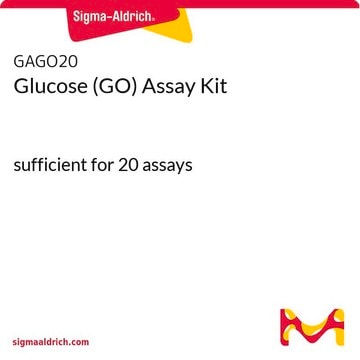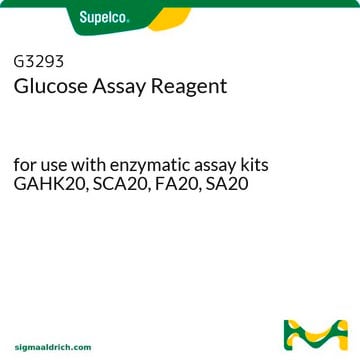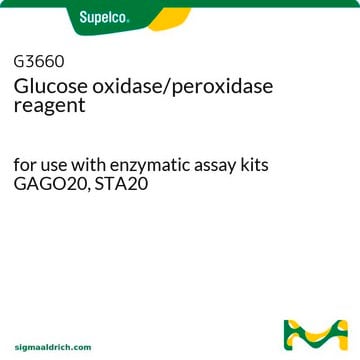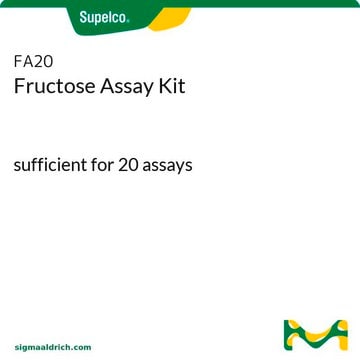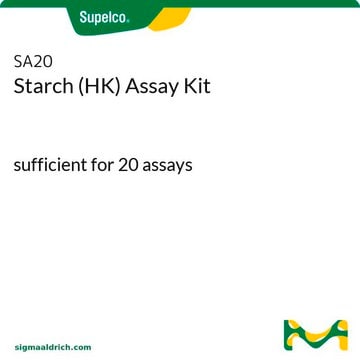If this product has an expiration or retest date, it will be shown on the Certificate of Analysis (COA, CofA). If there is no retest or expiration date listed on the product's COA, we do not have suitable stability data to determine a shelf life. For these products, the only date on the COA will be the release date; a retest, expiration, or use-by-date will not be displayed.
For all products, we recommend handling per defined conditions as printed in our product literature and website product descriptions. We recommend that products should be routinely inspected by customers to ensure they perform as expected.
For products without retest or expiration dates, our standard warranty of 1 year from the date of shipment is applicable.
For more information, please refer to the Product Dating Information document: https://www.sigmaaldrich.com/deepweb/assets/sigmaaldrich/marketing/global/documents/449/386/product-dating-information-mk.pdf
GAHK20
Glucose (HK) Assay Kit
sufficient for 20 assays
Synonym(s):
Glucose Quantification Kit
Select a Size
Select a Size
About This Item
Recommended Products
usage
sufficient for 20 assays
Quality Level
analyte chemical class(es)
sugars (glucose)
technique(s)
photometry: suitable
application(s)
food and beverages
general analytical
storage temp.
2-8°C
Application
Kit Components Only
- glucose (HK) assay reagent 20 mL
- glucose standard .5 mL
related product
Storage Class
10 - Combustible liquids
Choose from one of the most recent versions:
Certificates of Analysis (COA)
Don't see the Right Version?
If you require a particular version, you can look up a specific certificate by the Lot or Batch number.
Already Own This Product?
Find documentation for the products that you have recently purchased in the Document Library.
Customers Also Viewed
-
How can I determine the shelf life / expiration / retest date of this product?
1 answer-
Helpful?
-
-
How is shipping temperature determined? And how is it related to the product storage temperature?
1 answer-
Products may be shipped at a different temperature than the recommended long-term storage temperature. If the product quality is sensitive to short-term exposure to conditions other than the recommended long-term storage, it will be shipped on wet or dry-ice. If the product quality is NOT affected by short-term exposure to conditions other than the recommended long-term storage, it will be shipped at ambient temperature. As shipping routes are configured for minimum transit times, shipping at ambient temperature helps control shipping costs for our customers. For more information, please refer to the Storage and Transport Conditions document: https://www.sigmaaldrich.com/deepweb/assets/sigmaaldrich/marketing/global/documents/316/622/storage-transport-conditions-mk.pdf
Helpful?
-
-
The procedure says that solutions that are strongly colored should be decolorized for the kit to work. Do you have any suggestions on how to decolorize my sample?
1 answer-
Solutions may be decolorized by adding a small amount of charcoal, stirring a few moments, and then clarifying by filtration or centrifugation to remove the charcoal. An activated charcoal product, such as item 161551 would be appropriate. See the link below to review this product:
https://www.sigmaaldrich.com/product/sigald/161551Helpful?
-
-
I want to detect the change of glucose concentration in macrophages. How to prepare the sample
1 answer-
A macrophage sample should be lysed using a cell lysis protocol similar to one used for Western Blotting. A useful lysis protocol can be found linked below.
Following cell lysis, the sample should be diluted with deionized water to 0.05 to 5 mg of glucose per mL. The sample should be deproteinized (using a common perchloric acid precipitation procedure) and filtered to clarify the solution. Any solutions that are strongly colored should be decolorized using a decolorization agent such as activated charcoal. Any samples in which gases are liberated during the sample preparation process should be degassed prior to analysis.
Helpful?
-
-
How to adapt the Glucose Assay Kit to a 96-well plate?
1 answer-
It may be possible to adapt this kit for use in a 96-well plate format. This would require method development and reagent scale down by the end user. There are no specific instructions available. Should a 96-well assay be preferred or required, please see product MAK476 at the link below. This product has been optimized for use in this format.
https://www.sigmaaldrich.com/product/sigma/mak476Helpful?
-
-
Is the product G3293-20ML included in the GAHK20-1KT kit?
1 answer-
Yes, the item G3293-20ML is a component of the complete GAHK20-1KT kit. Therefore, if G3293-20ML is on backorder, it can be obtained by ordering the GAHK20-1KT.
Helpful?
-
-
Is GAHK20 assay compatible with C. elegans worm lysates? What buffer you recommed to prepare lysates?
1 answer-
The Glucose (HK) Assay Kit has been optimized for use in food and other crude materials. This kit has not been qualified for use with cells or organisms such as C. elegans. The researcher would have to determine suitability, however there is some indication that other customers have been successful. See the link below for a publication that may be of interest:
https://journals.plos.org/plosgenetics/article/file?id=10.1371/journal.pgen.1005561&type=printableNote that samples may require centrifugation, filtration or deproteinization to further clarify.
Helpful?
-
-
Can the procedure for Glucose (HK) Assay Kit, Product GAHK20, be scaled down?
1 answer-
Although we have not done it, you should be able to scale down the procedure as long as you have pipettes capable of dispensing accurate ul volume quantities and an instrument that can monitor the 340 nm wavelength.
Helpful?
-
-
What is the Department of Transportation shipping information for this product?
1 answer-
Transportation information can be found in Section 14 of the product's (M)SDS.To access the shipping information for this material, use the link on the product detail page for the product.
Helpful?
-
-
How do I decolorize a solution for use with Product GAHK20, Glucose (HK) Assay Kit?
1 answer-
You can decolorize a solution by adding a small amount of charcoal to the solution, swirl, then filter or centrifuge to remove charcoal.
Helpful?
-
Active Filters
Our team of scientists has experience in all areas of research including Life Science, Material Science, Chemical Synthesis, Chromatography, Analytical and many others.
Contact Technical Service